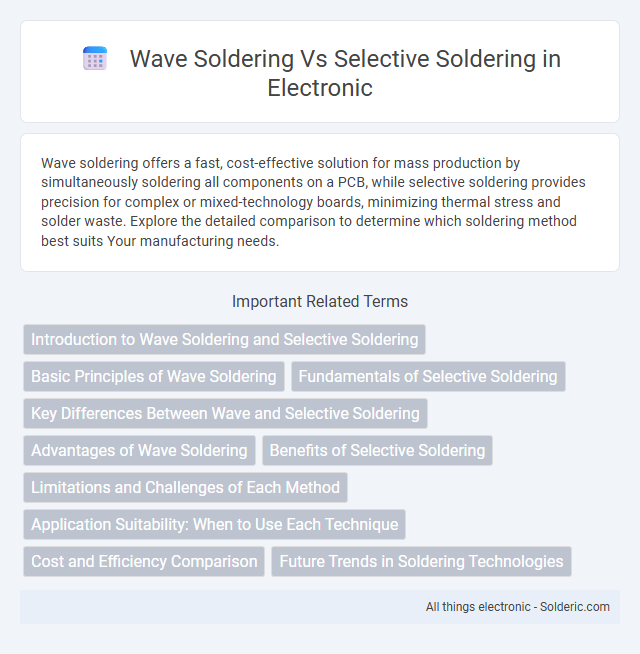Wave soldering offers a fast, cost-effective solution for mass production by simultaneously soldering all components on a PCB, while selective soldering provides precision for complex or mixed-technology boards, minimizing thermal stress and solder waste. Explore the detailed comparison to determine which soldering method best suits Your manufacturing needs.
Comparison Table
| Feature | Wave Soldering | Selective Soldering |
|---|---|---|
| Process Type | Mass soldering using a wave of molten solder | Targeted soldering of specific PCB areas |
| Application | Through-hole components, mixed technology PCBs | Surface-mount components, complex boards, sensitive areas |
| Soldering Speed | High throughput, suitable for large batches | Slower, precise for selective joints |
| Cost | Lower per unit for high volume | Higher due to complexity and precision |
| PCB Damage Risk | Higher risk due to full board exposure | Lower risk; solder only on targeted areas |
| Flux Usage | Uniform flux application on entire PCB | Localized flux application |
| Solder Alloy | Commonly leaded or lead-free alloys | Same solder alloys but more controlled delivery |
| Typical Industries | Consumer electronics, automotive, industrial | Aerospace, medical devices, complex PCB assembly |
Introduction to Wave Soldering and Selective Soldering
Wave soldering efficiently assembles through-hole electronic components by passing the PCB over a wave of molten solder for rapid and consistent connections. Selective soldering targets specific areas on densely populated PCBs using a localized solder jet, preserving sensitive components and minimizing thermal stress. Your choice depends on PCB design complexity, production volume, and component sensitivity to heat.
Basic Principles of Wave Soldering
Wave soldering utilizes a continuous wave of molten solder to simultaneously solder electronic components to the underside of printed circuit boards (PCBs). The PCB is passed over a standing solder wave, allowing solder to adhere to exposed metallic areas and create strong, reliable connections. This method is efficient for through-hole components but less suitable for mixed-technology or high-density assemblies where selective soldering offers precise application.
Fundamentals of Selective Soldering
Selective soldering uses a precise, localized soldering process that targets specific components on a printed circuit board (PCB) without exposing the entire assembly to heat. This method employs a mini-wave or jet of solder, controlled by robotic positioning systems to ensure accuracy and reduce thermal stress on sensitive components. Unlike wave soldering, which submerges the entire PCB in molten solder, selective soldering minimizes solder bridges and enhances reliability for complex or mixed-technology boards.
Key Differences Between Wave and Selective Soldering
Wave soldering uses a continuous wave of molten solder to simultaneously solder all components on a PCB, making it ideal for through-hole technology and high-volume production. Selective soldering targets specific areas using a precise mini-wave or solder nozzle, perfect for complex boards with mixed or sensitive components. Your choice depends on factors like component type, board complexity, and production scale, as wave soldering suits mass production, while selective soldering offers accuracy and minimizes thermal stress.
Advantages of Wave Soldering
Wave soldering offers high throughput and cost efficiency, making it ideal for large-scale PCB assembly with through-hole components. This process ensures uniform solder joints by immersing boards in a continuous wave of molten solder, which enhances reliability and reduces defects. Your production benefits from faster cycle times and lower labor requirements compared to selective soldering methods.
Benefits of Selective Soldering
Selective soldering offers precise control when soldering only specific components, minimizing thermal stress on sensitive parts compared to wave soldering. It significantly reduces solder bridging and defects on complex, densely populated PCBs. This method also enables efficient processing of mixed technology boards, enhancing overall assembly quality and yield.
Limitations and Challenges of Each Method
Wave soldering faces limitations in handling complex or densely populated PCBs due to its inability to precisely control solder application, leading to potential solder bridges and thermal stress on sensitive components. Selective soldering offers improved accuracy and reduced thermal impact but presents challenges in cycle time and equipment cost, often making it less efficient for high-volume production. Your choice depends on balancing these factors with specific PCB design requirements and production scale.
Application Suitability: When to Use Each Technique
Wave soldering is ideal for high-volume production of through-hole components on printed circuit boards (PCBs), offering fast and uniform soldering for densely populated boards. Selective soldering targets specific areas or components, making it suitable for mixed-technology assemblies where precise soldering is needed without damaging sensitive parts. You should choose wave soldering for cost-effective mass production and selective soldering when complex layouts or delicate components require accuracy and control.
Cost and Efficiency Comparison
Wave soldering offers lower initial equipment costs and faster processing speeds suitable for high-volume production of through-hole components. Selective soldering, while more expensive upfront, provides greater efficiency in handling complex or mixed-technology assemblies by minimizing thermal stress and solder defects. Cost-efficiency depends on production complexity and volume, with wave soldering favored for large runs and selective soldering ideal for precision and rework scenarios.
Future Trends in Soldering Technologies
Wave soldering and selective soldering are evolving with advancements in automation and precision, meeting the demands of miniaturized and complex electronic assemblies. Emerging trends emphasize increased process control, reduced thermal stress, and integration with Industry 4.0 for real-time monitoring and data analytics. Selective soldering shows significant growth due to its ability to handle mixed-technology boards and environmentally friendly soldering materials.
wave soldering vs selective soldering Infographic

 solderic.com
solderic.com